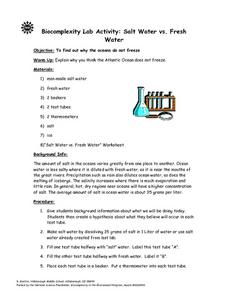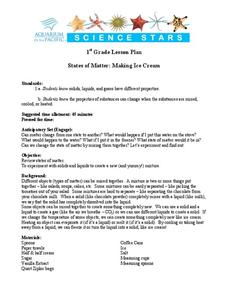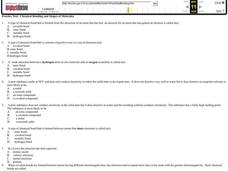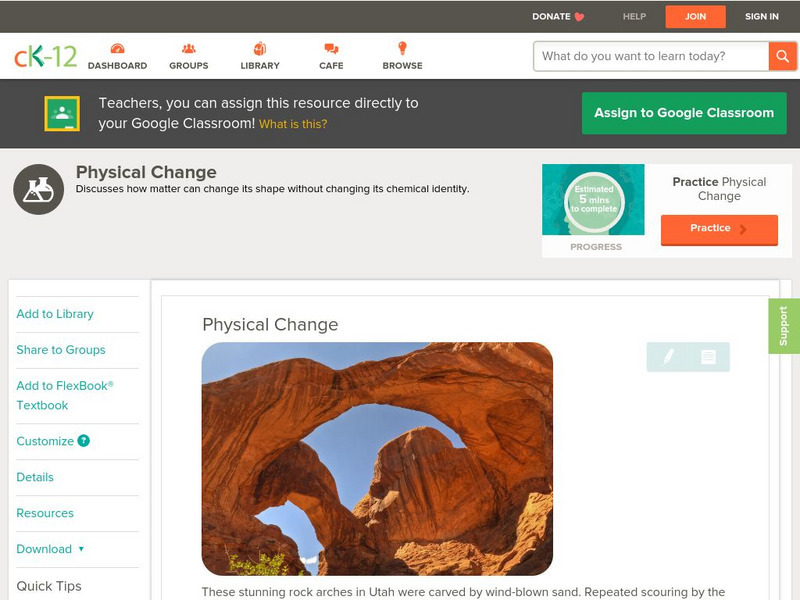Curated OER
Salt Water vs. Fresh Water
Middle schoolers explore why the oceans do not freeze. They explain why they think the Atlantic Ocean does not freeze. Students are given background information about what they are doing. They create a hypothesis about what they...
Curated OER
Changes In Matter, Not In Weight
Fifth graders investigate different objects and the examine the correlation of mass and weight. They conduct the experiment with the help of background information provided by the teacher and record observations before making...
Curated OER
Vocabulary Practice: Cross Out the Incorrect Word
In this editing instructional activity, students read ten sentences and look for the error. Students cross out the incorrect word and replace it with the logical word from the word list.
Curated OER
Making Ice Cream
First graders create ice cream in class. In this matter lesson, 1st graders discover solids, liquids and gases and the properties of each. Students produce a batch of ice cream in class using household items.
Curated OER
Halogens
Students identify the elements that belong to the halogen family on the periodic table. In this chemistry lesson, students describe the common characteristics of elements in this group. They research about hydrochloric acid's effect on...
Curated OER
Thin Layer Chromatography (TLC)
Learners study flavinoids and how they exist in the plant kingdom. In this pigment lesson students complete a lab activity to see how flavinoids move in substances then record their observations.
Curated OER
Chemical Bonding and Shapes of Molecules
In this chemical bonding learning exercise, students review the different types of bonds and calculate the number of valence electrons in molecules. This learning exercise has 11 matching and 15 multiple choice questions.
Curated OER
Ice Cream Blizzards
Fourth graders explore whether the making of homemade ice cream is a physical change or a chemical change in a lab experiment. Students identify states of matter, describe the physical properties of states, and collect temperature data...
Curated OER
Condensation and the Water Cycle
Students explore the natural distallation process that occurs in the water cycle. They use plastic cups and cotton swabs to observe the condensation process that is evident in the water cycle.
Curated OER
Ocean Water
Given data about the composition of ocean water, students complete 5 different questions using a provded table that relate to the ocean water (with elements Chloride, Sodium, Sulfate, and Magnesium). Some questions require calculation,...
Curated OER
Volcano Study Guide
In this volcano learning exercise, students answer fourteen questions about the types of volcanoes, the types of magma and the types of lava. They label the parts of a volcano.
Curated OER
Properties of Ionic Compounds
In this compounds instructional activity, students describe why metals and nonmetals form ionic compounds and why the formation of ionic compounds are exothermic. This instructional activity has 5 short answer questions.
Curated OER
Making Soap
Students recognize and use chemical indicators in the lab, recognize the need for safety while doing chemical experiments and understand the need for following precise directions.
Curated OER
Classification of Changes
In this classification of changes worksheet, students identify each example as either chemical or physical changes. Students also classify other examples as either element, compound, solution, colloid, or suspensions. In the other...
Curated OER
Recipe for Beignets
In this reading and following directions instructional activity, students read and make New Orleans beignets. Students follow 10 directions.
Curated OER
Chemistry: Changing Materials
Students examine physical change with different temperature and solvents. In this elements and compounds lesson, students conduct experiments to discover what happens to the mass of a substance when is undergoes a physical change.
Curated OER
Flower Pigments
Middle schoolers experiment with Thin Layer Chromatography to separate pigments found in flower petals.
Curated OER
Let's Think About Water
Students explore the different forms that water can take and conduct simple experiments to demonstrate some of its properties in each state. They watch a short video that illustrates some of these concepts.
Curated OER
Chemistry Practice
In this chemistry practice worksheet, students select the correct response to the given questions. Students apply knowledge about the states of matter, finding vapor pressure and atmospheric pressure.
Science Struck
Science Struck: Can Diamonds Be Melted or Dissolved?
While diamonds are extremely hard and strong, they are not indestructible. Learn how diamonds can be burned, melted, or dissolved.
Science Fun for Everyone
Science Fun: Gorgeous Gooey Gobstoppers
Watch the masterpiece you create when you dissolve 10 gobstoppers in a bowl of water. Video explanation included.
BBC
Bbc Schools: Ks2 Bitesize: Science: Materials: Changes in Materials
Help solve the mystery and find the missing crystal. Following the activity, read more about chemical and physical changes, and then take a quick quiz to check for understanding.
CK-12 Foundation
Ck 12: Chemistry: Physical Change
[Free Registration/Login may be required to access all resource tools.] Definition of physical change and examples, and how physical changes can be reversed.
PBS
Pbs Teachers: Rising Ice Experiment
Observe how ice and salt crystals interact by using salt to help adhere a string to the top of an ice cube in a glass of water, then lift the cube out of the water.
























